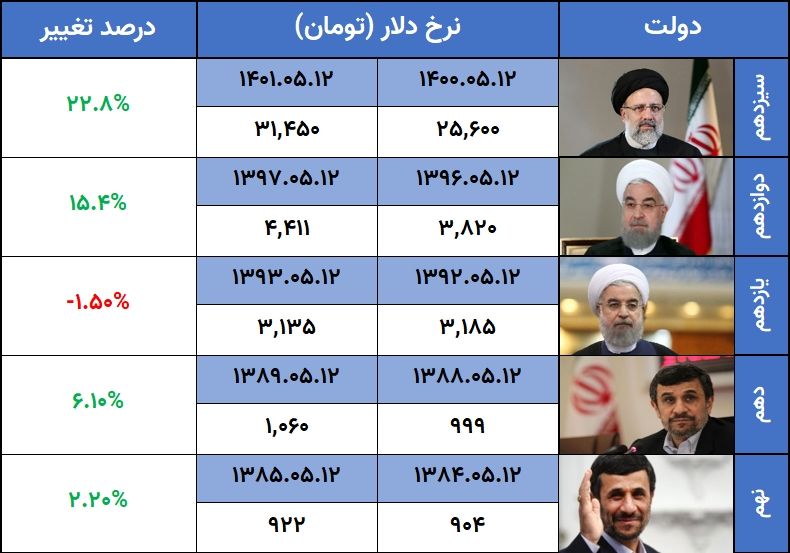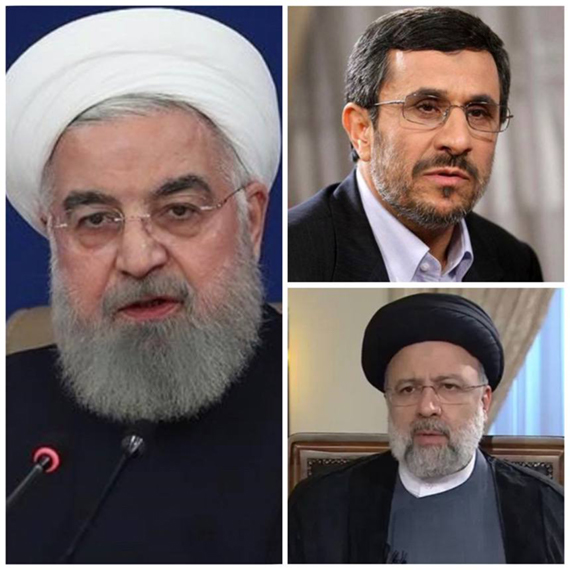Rejection of Raisi’s Government in the Currency Market
According to Irangate, the thirteenth government marked its first year amid growing concerns among economic actors about instability in various sectors. Financial markets are experiencing unstable conditions, and statistics indicate disappointing performance by the government in managing the country’s economy.
The exchange rate of the dollar has always held a special place among citizens and investors as one of the most important economic factors. For instance, to assess the performance of governments, the fluctuations in the exchange rate over a specific period are often referenced. Naturally, the smaller the range of price fluctuations in the free market, the more it indicates relative economic stability in the country and the stability of the rial’s value compared to the world’s strong currencies.
Therefore, on the occasion of the first anniversary of Ebrahim Raisi’s government, it is worthwhile to look at the state of the currency market and compare the performance of the thirteenth government in this area with the first-year records of each of the previous governments over the past 20 years.
The Thirteenth Government of Ebrahim Raisi
Seyyed Ebrahim Raisi took charge of steering the government on August 3, 2021, at a time when the dollar rate had reached relative stability. The twelfth government, despite severe tensions in international relations and consequently the country’s economy, had managed to control the surges in the dollar rate to a large extent.
However, during the thirteenth presidential election campaign, Ebrahim Raisi repeatedly criticized the performance of Rouhani’s government in the currency market. Hojatollah Abdolmaleki, who was one of Raisi’s supporters in the election and incidentally was appointed as the Minister of Labor in the thirteenth government, also described controlling the exchange rate as a simple and achievable task.
Abdolmaleki even talked about controlling the dollar rate and stabilizing it below the 20,000-toman range by injecting billions of dollars into the market. Nevertheless, the thirteenth government took the helm of the country when the dollar was being traded in the 25,000-toman range in the Tehran free market.
However, it didn’t take long for the dollar rate in the free market to break its historical record and reach the highest price ever recorded in Iran’s economic history. In June of this year, amid a climate of concern among economic actors, the dollar entered the 33,000-toman range.
The government also tried to moderate market conditions by implementing security measures in the currency market and banning the publication of the free market rate for all media in the country. These actions caused the exchange rate, albeit temporarily, to take a not-so-extensive downward trend, but the dollar rate in the free market never again saw the range below 30,000 tomans.

Although at times when hopeful news about Iran’s nuclear file was released, the currency market also reacted positively, and the dollar rate consequently decreased. Recently, the same mechanism caused the exchange rate to drop to the 31,500-toman range on August 3, 2022.
Comparing the fluctuations in the exchange rate on the first anniversary of the thirteenth government shows the weakest performance of a government in the currency market, such that the dollar rate in the free market was recorded at 25,600 tomans on August 3 of the previous year.
The trend of dollar rate changes progressed in such a way that on August 3, 2022, the price of 31,450 tomans was recorded. These figures indicate a 228% increase in the dollar rate in just the first year of Seyyed Ebrahim Raisi’s presidency. Comparing this amount with the same period for five governments in the past 20 years shows the weakest performance by Raisi’s government. The following examines the statistics related to dollar rate changes in the first year of the four previous governments.
The Twelfth Government, Hassan Rouhani’s Second Government
Hassan Rouhani formed his second government at a time when Donald Trump held power in the White House, and multiple crises were forming in international relations for Iran. Nevertheless, the twelfth government managed to control the surge in the exchange rate in the free market to a large extent in its first year of operation.
The dollar rate on August 3, 2017, when the twelfth government officially formed, was traded in the 3,820-toman range, but exactly at the end of the first year of the twelfth government, the figure of 4,411 tomans for the free market dollar rate was recorded. This amount of increase means a 154% growth in the dollar rate during this period. This is while the twelfth government faced various international crises, especially regarding the nuclear file and the White House’s movements led by Trump.
The Eleventh Government, Hassan Rouhani’s First Government
Hassan Rouhani assumed the presidency on August 3, 2013, when the dollar was being traded at 3,185 tomans in the free market. The currency market had experienced extensive surges in the dollar rate in the two years prior to Rouhani’s administration, and prices were highly unstable.
However, with the start of Hassan Rouhani’s government in the summer of 2013 and the initiation of nuclear negotiations with the P5+1 countries, the country’s financial markets began to stabilize. This condition led to a 0.1% decrease in the dollar rate during the first year of the eleventh government. This trend resulted in the stabilization of the dollar rate in the 3,135-toman range on August 3, 2014.
It should not be forgotten that the devastating crisis of financial and credit institutions inherited from the tenth government also had a widespread adverse effect on the stabilization of the exchange rate. The decline in the country’s foreign exchange revenues due to the imposition of oil and banking sanctions was another factor that made the situation much more difficult for the government’s economic team.
The Tenth Government, Mahmoud Ahmadinejad’s Second Government
Mahmoud Ahmadinejad’s second government was formed amid a highly turbulent political, social, and consequently economic environment in the country. However, oil revenues due to the unprecedented increase in oil prices and the non-expansion of sanctions in 2009 allowed the currency market to experience a relatively stable situation in the first year of the tenth government, such that the dollar rate on August 3, 2010, grew by 0.6% from the 999-toman range in 2009 to 1,060 tomans.
The Ninth Government, Mahmoud Ahmadinejad’s First Government
On August 3, 2005, the people of Iran witnessed the formation of one of the most controversial governments in the history of the Islamic Republic of Iran. Mahmoud Ahmadinejad succeeded in winning the second round of the ninth presidential election.
Anyway, the currency market in the first year of Ahmadinejad’s presidency also faced rising prices, such that the 904-toman dollar rate on August 3, 2005, stabilized in the 922-toman range after one year. This price increase also means a growth of over 0.2% during the first year of the ninth government.
Raisi’s Government: The Biggest Loser in the Currency Market
As observed in the above report, the thirteenth government has shown the weakest performance in managing the currency market within the specified time frame. This incident occurs while the government has not faced a new crisis in the international arena or crippling banking and oil sanctions in the past year.
In other words, it can be said that Raisi’s government, despite the overall stability in the country’s general atmosphere, could not maintain the value of the national currency even to the extent that its predecessors had. This is while, according to this comparative report, the exchange rate has mainly experienced severe surges when the country has been grappling with serious crises.
Therefore, it can be said that the claims of Raisi and his supporters during the presidential election campaign about the jihadist management of the currency market have not materialized in reality.
Statistics show that the thirteenth government has not only failed to stop the decline in the national currency’s value but has also exacerbated the situation with unwise actions, including securitizing the currency market and preventing the free circulation of information in the country’s economic media.

